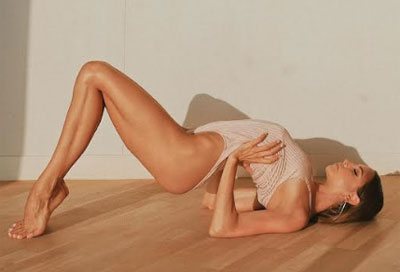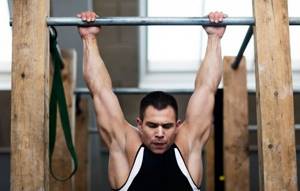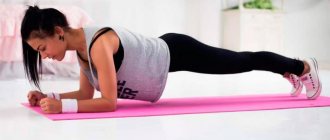The abdominal vacuum exercise came to fitness and bodybuilding from yoga. As a result of regular training and strictly following the technique, you will achieve weight loss and make your waist truly thin.
Many people dream of a flat stomach and thin waist. Disappointment occurs when heavy abdominal exercises do not bring the desired results. During pumping of the press, muscle fibers hypertrophy, as a result of which the waist increases in volume. A vacuum will help narrow this area as much as possible. It will improve digestion and even help get rid of back pain. It can be included in the training complex for both complete beginners and advanced bodybuilders. Perfect for young mothers who want to get rid of their postpartum belly.
How does a stomach vacuum differ from regular abdominal exercises?
Conventional abdominal exercises (lifting the body, legs, crunches, etc.) involve the external rectus and oblique abdominal muscles to a greater extent. They form relief and cubes. The transverse muscles are responsible for a flat stomach, which are practically not used during regular abdominal exercises.
The vacuum exercise involves the work of the internal abdominal muscles - the transverse ones, which lie under the straight and external obliques. Strong transverse muscles prevent the stomach from protruding; they literally “hold the stomach.” This exercise was used by bodybuilders of the “old school”, thanks to which they looked more harmonious compared to the athletes of our time, pumped up to incredible sizes. A good example is Arnold Schwarzenegger, who during his sports career had an ideal V-profile figure.
Now a little theory.
Abdominal muscles include:
straight; external obliques; internal obliques; transverse.
The main difference between the abdominal vacuum exercise and regular abdominal exercises is that only it can make your stomach flat and your waist thin without pumping up the abs.
Where does this exercise come from?
Have you noticed this paradox: a person trains hard, breaks a sweat in the gym, but still has a round tummy? What can we say about those who cannot (or do not want) to train hard.
I studied the opinions of doctors, trainers, nutritionists - indeed, the abdominal muscles are not easy to train. Especially by the age of 30, many become the owners of a round belly. And no matter how hard you fight, it still doesn’t decrease.
Trainers unanimously say that ordinary exercises are not enough to get the abdominal muscles to work. This is due to the anatomy of the abdominals. During the well-known abdominal workouts, the internal muscles are practically turned off.
The vacuum exercise is aimed at working these muscles. This exercise is popular among bodybuilders. They practice vacuum both in training and to demonstrate muscle definition. Body-drying athletes know this exercise well. To prepare for competitions and quickly tone the body, athletes perform a vacuum.
Among the celebrities who practice this technique are Arnold Schwarzenegger, Mariah Carey, Alexander Vasiliev (“Splin”), Frank Zane (bodybuilder).

There are even special breathing exercises for losing weight in the abdomen and sides. As those who have tried it write, after regular exercise, the feeling of hunger is dulled and well-being improves.
Technique for performing the vacuum exercise
There are four classic options for performing the vacuum exercise for beginners, as well as variations for pros. Experts recommend starting to master the technique from a lying or standing position. As you progress, move on to more complex options. It is in these poses that it is easier to control the abdominal muscles, which is very important when performing the exercise.
Options for performing the vacuum exercise for beginners:
vacuum lying on your back; standing vacuum; vacuum sitting; vacuum standing on all fours.
Vacuum of the abdomen lying on the back
- Take a lying position, bend your knees.
- Slowly inhale as deeply as possible through your nose.
- Exhale sharply through your mouth. It is important to exhale all the air!
- Pull your stomach under your ribs as much as possible (your navel should seem to “stick” to your spine). If possible, hold in this state for 15 seconds. If at first it is difficult to stay for a long time without air, then start with 10 seconds or, as necessary, take a series of short breaths through the nose.
- Without completely relaxing your stomach, take a couple of shallow breaths.
- Perform 3 sets of 10 repetitions.

Standing abdominal vacuum
- Feet shoulder-width apart, back straight, hands on hips - this is your starting position.
- Inhale slowly and deeply through your nose.
- Exhaling powerfully through your mouth, completely empty your lungs of air and draw in your stomach as much as possible. Hold for 15 seconds.
- After the time is up, take a few breaths without bloating your stomach.
- Perform 3 sets of 10 repetitions.
Tip: You can round your back and rest your hands on your slightly bent knees. For many, it is easier to perform the exercise from this position.
Sitting abdominal vacuum
- Sit on a fitball, chair or any hard surface. Keep your feet on the floor at an angle of 90 degrees to each other. Place your palms on your knees. Don't use the back of the chair as a support!
- The remaining actions are completely similar to the previous options discussed above: take a deep breath through your nose, exhale sharply and draw in your stomach.
- After holding this position for 15 seconds, take a few breaths and exhale and repeat the exercise again. So 3 sets of 10 repetitions.

For information: when performing a vacuum exercise in a sitting position, in addition to the transverse abdominal muscles, the stabilizing muscles of the back, which are responsible for beautiful posture and a thin waist, are included in the work.
Abdominal vacuum standing on all fours
- Standing on all fours, place your hands on the floor. Your wrists, elbows, and shoulders should be aligned, and your hips should be bent at a 90-degree angle to your shins. Make sure that your back does not round or sag, and that your chest is straightened.
- Then everything is the same as in the previous versions: deep breath, sharp exhalation, retraction of the abdomen. Repeat the specified number of times.
Options for performing the vacuum exercise for the pros
Once you have fully mastered the four vacuum variations for beginners, you can try the exercises for professionals. For example, combine a vacuum with a bar. Here, in addition to the internal abdominal muscles, the core muscles will be involved. This can be a classic plank from a face down position or a reverse plank from a chest up position.
Combination of vacuum with classic bar
- Get into a prone position, resting on your toes and elbows/forearms (arms should be bent at 90 degrees and your body should be in a straight line from head to heels).
- Take a deep breath through your nose.
- Exhale sharply, completely emptying your lungs of air.
- Pull your stomach in and hold this position for 15 seconds.
- Take a few breaths.
- Repeat the exercise a specified number of times. Typically 3 sets of 10 reps.

Vacuum wave Nauli
- Do the exercise based on the “standing abdominal vacuum” option. That is, feet shoulder-width apart, back straight, hands on hips.
- Take a deep breath through your nose.
- Exhale sharply and draw in your stomach.
- While holding your breath, relax a little and draw in your stomach again.
- After several such “fluffing” movements, release the air from your stomach again and draw it in as much as possible.
- Repeat the exercise several times. The bigger, the better.
Abdominal retraction according to the yoga method
By the way, many yogis constantly perform the vacuum exercise in the stomach. Of course, you are unlikely to be able to repeat their level of performance, since they do about 200 inhalations in one breath-hold. But you should also strive to gradually increase their number each time. Then the result will appear much faster. Tightening the abdomen in yoga is a complex, but most effective method for tightening the skin.
How to tighten your stomach using the yoga method? To do this, you need to stand with your feet slightly wider than shoulder-width apart. Now you need to bend over, resting your hands on your hips. You need to keep your back straight, so you should bend your body not in the lower back, but in the pelvic area. To make it more comfortable, you can bend your legs slightly. Leaning slightly, exhale through your mouth, rising to the previous position, drawing in your stomach as much as possible.
It is better to lower your chin, otherwise you will be tormented by a cough. While this delay is in progress, quickly relax your abdominal muscles and draw it in again. The first time, you will only be able to do it 2-5 times in one breath-hold. Now you can inhale slowly, straighten your back and take 2 breaths. You can repeat the exercise from 3 to 10 times, it depends on your abilities. But never do it forcefully.
How to do the abdominal vacuum exercise correctly
Despite the apparent ease of performing this exercise, doing a stomach vacuum correctly is not easy. For maximum effect, pay attention to the following points.
Breath
It must be correct - this is the main stage in the vacuum exercise. Take a deep breath through your nose, and exhale sharply through your mouth. The exhalation should be sharp and maximum until the lungs are completely empty of air.
There is a second way of breathing from the bodyflex technique: fold your lips into a tube, slowly blow out all the air through your mouth. Then, noisily, take a sharp breath in through your nose and also quickly exhale through your mouth, you should get the sound “groin.” Then draw your stomach towards your spine.
Learn to suck in your stomach as much as possible. The more you pull it in, the better the transverse muscles will contract. As a result, the effect of losing belly fat will be faster and more pronounced.
Relaxation
Another important point in the vacuum exercise. During the break between repetitions, you cannot completely relax your abdominal muscles. The effectiveness of the exercise for weight loss depends on this. After holding your breath, do not stick your stomach sharply forward, gently relax it and not completely.
Number of repetitions
Many people say that you need to do a minimum of 10 repetitions. In fact, what matters more is not the quantity, but the delay time and quality of the exercise. As you master the vacuum, try to increase the time you hold your breath from 15 seconds to 30 or more.
Arnold Schwarzenegger once held his breath for up to a minute!
Time for training
A vacuum exercise for losing weight in your belly will only be effective if you do it at a certain time. Namely: in the morning before breakfast on an empty stomach (you can’t even drink) and in the evening before bed, 3-4 hours after your last meal.
Watch this instructional video on how to perform the abdominal vacuum exercise.
How to do it right
You need to do the exercise in the morning on an empty stomach and after visiting the toilet. There are several options for implementation:
- standing
- lying down;
- sitting on a chair;
- On knees.
It is better to start practicing the exercise from a standing position. This position will give you the opportunity to better feel how your abdominal muscles work. Stand as if you were roller skating: feet shoulder-width apart, body forward, hands on knees. Take a deep breath, exhale completely, hold your breath and draw in your stomach. Count in this position to 5. Do 10 approaches. Between each of them, do not forget to breathe deeply. If something is still unclear to you, it is better to watch the training video. There are a lot of such videos on the Internet.
We tighten our abs
The next option is a little more complicated. You need to do everything as before, but as you exhale, draw in your stomach, straighten up and tense your abs. Keep your muscles tense for as long as possible. With this exercise, Schwarzenegger himself gave himself a narrow waist and chic abs.
Benefits of abdominal vacuum exercises
The vacuum exercise is of great benefit for losing weight in the abdomen and the body as a whole. By doing it every morning and evening, you can count on the following pleasant bonuses:
the stomach becomes flat and toned without the risk of pumping up the abs; a beautiful waist line is formed; abdominal volume decreases; visceral fat is burned, which is considered dangerous to health; the figure will acquire ideal shape: V-profile for men and X-profile for girls; the stomach comes into shape faster after childbirth; Diastasis is reduced (the exercise is performed without the abdominal bloating phase; pain in the lower back is reduced; prolapse of the abdominal organs is prevented; blood supply to internal organs is improved; metabolism is accelerated; digestion is improved.
Contraindications, consequences and precautions
Vacuum, such an effective and seemingly simple exercise, has many contraindications, and with age, performing this “trick” is not recommended for almost anyone.
Contraindications
It is not customary to talk about contraindications and harm among fans of these exercises, but they exist. Moreover, ignoring them can lead to quite unpleasant consequences. Using a vacuum is strictly prohibited when:
- Pregnancy
- Menstruation and atypical discharge
- Diseases of the abdominal and pelvic organs
- Uterine fibroids
- Infectious diseases
- Thromboembolic disease
- Exacerbation of chronic diseases of the digestive system
- Glaucoma
- Heart diseases
- Increased intracranial pressure
- Malignant tumors
- The course of the postoperative period
Consequences of incorrectly performing a vacuum or ignoring contraindications
Ignoring contraindications can lead to aggravation of existing diseases and the emergence of complications. A vacuum is a serious exercise, during which compression of internal organs occurs. During menstruation, such a load can lead to a complete failure of the cycle, as well as to many gynecological disorders. You can return to training only after the end of menstruation. It is very dangerous to ignore this fact and put training before health.
Precautionary measures
If there are no obvious health problems, but during the exercise you experience pain, suffocation, nausea, or dizziness, then you should definitely stop training and consult a doctor. Perhaps these symptoms are indicators of some diseases and abnormalities that must be identified and taken into account in the future when choosing an exercise plan for training.

Results and reviews
Reducing abdominal volume will depend on the regularity of performing the vacuum exercise. To evaluate the results, it will take a month of constant training, provided that they are performed correctly. If you read the reviews (and they are only positive), it becomes clear that the vacuum exercise is actually extremely effective and useful.
The results before and after a month of regular training are impressive - minus 2.5-5 cm in the waist!
You should also understand that if you have a large waist size that is associated not only with weak abdominal muscles, but also with excess weight, then exercise alone will not solve the problem. Review your diet, increase your water intake, and start leading an active lifestyle. Only an integrated approach will produce results.
Beginner mistakes
- Remember to rest between repetitions. 30-40 seconds is enough.
- Do not vacuum on a full stomach. It's best to do it in the morning.
- If you feel dizzy, this is normal. Yawning may also occur due to lack of air. All these symptoms will go away with practice. But if you feel very dizzy, stop. You should not continue if you feel unwell.
You will succeed if you practice regularly. By playing sports all your life, you will feel great and look young and slim. What if you work out for a month and then quit and say “this doesn’t work.” So there will definitely be no result.

Contraindications to performing the vacuum exercise
The vacuum exercise makes our waist thin, eliminates visceral fat, and prevents sagging internal organs. However, it is not useful for everyone.
Abdominal vacuum exercise is contraindicated in the following cases:
during pregnancy; for diseases of the lungs and cardiovascular system; at the time of exacerbation of stomach and duodenal ulcers; on critical days (especially when they are painful); with diastasis (you can perform the exercise without the abdominal bloating phase); if there is a hernia in the abdominal cavity; for any pain and discomfort in the abdomen; It cannot be done immediately after childbirth and abdominal surgery; several months must pass.
Harm to health
All positive effects will be nullified if this exercise is performed incorrectly. Moreover, violation of the plank technique can seriously harm your health.
The main condition is an even position of the body parallel to the floor. Under no circumstances should you stick your buttocks up or arch your lower back.

- Improper stress on the spine is the most common danger of planking. Scientist Stuart McGill from the State University of Waterloo in Canada, through research, has proven that such a load should not be given to the body immediately after sleep. This is due to the fact that at night the vertebral discs actively absorb water from the body, and early in the morning they are especially vulnerable. Therefore, it is necessary to postpone this exercise for 1-2 hours after getting up. It is also not recommended to perform the plank after 21:00, as during this period of time the spinal discs shrink and become more fragile.
- Provoking hypertension is a consequence of static tension in the plank position. Compression and tension of almost all the muscles of the shoulder girdle, as well as the oblique and smooth muscles of the abdomen, lead to a weakening of the outflow of blood through these tissues. Pressure on large vessels causes increased stress on the heart. Medical studies have proven: the more a person exposes himself to static training and vasospasm, the faster he develops hypertension.

To eliminate errors in the technique of performing vacuum and plank exercises, and also to have confidence that such loads will not harm your health, you must always be under the supervision of an experienced trainer and undergo regular medical examinations. Sports should bring benefits and pleasure, and not provoke diseases and injuries. You need to approach the issue of your own health responsibly, and then any sporting success will be feasible and achievable.
Article protected by copyright and related rights. When using or reprinting material, an active link to the women's website www.inmoment.ru is required!
Tags: harm of exercises vacuum and plank
Let's summarize and give some advice
- Do not delay for less than 15 seconds - there will be no result.
- Control your breathing and tension of your abdominal muscles until the end of the breath hold.
- Perform the exercises only after you have completely exhaled.
- Pull your stomach so deep under your ribs until it is as close to your back as possible.
- First, master the exercise from easier positions - sitting or standing.
- To keep the transverse muscles constantly in tension, do not suddenly drop your stomach when inhaling after a delay.
- Perform the exercise only on an empty stomach.
A thin waist, flat stomach and correct proportions are not always a gift from nature. With the help of the vacuum exercise, you can make your stomach perfect, the main thing is not to lose heart and be persistent on the path to a beautiful body.
Vacuum, plank and others: TOP 5 useful exercises for lazy people from Sergei Pankov
Agree, not every one of us wants to have big muscles and be able to carry cars. For a person who works, has a family, children, and is interested in chess, this is simply not interesting. But having a healthy body is very necessary. I was involved in the circus, fitness, weightlifting, and over 15 years I gained my TOP exercises, which are a lifesaver for me. And these are the exercises that a physically healthy person simply must do - otherwise, that’s it.
Training in the yard is a labor-intensive task, especially in our conditions, when summer lasts a month at most, and the rest of the time you have to knock ice off your nose. Going to the gym takes a toll on your pocket. Home exercise equipment is not always convenient: our apartments are not that big. We all want to be healthy, but, as a rule, we don’t have the time and resources for this. Which, of course, is strange, considering that we are talking about our health, but it is a fact.
There is always a way out. I personally always look for the “lazy man’s way”. And there are such ways.
In selecting my exercises, I proceeded from the principle of “do no harm,” so the main criterion in selecting an exercise is safety. It is unlikely that you will be able to disrupt the biomechanics of the movements I have proposed and cause harm to the joints and ligaments.
And the first exercise that I put in the TOP is the vacuum .

I won’t go into anatomy, but I’ll just tell you in layman’s terms why this is important. I’ll tell you the example of girls - they will understand me right away. I often see ladies who are pretty, don’t seem to be overweight, but the lower abdomen (the so-called “tummy” - some consider it sexy) is a disaster.
The fact is that our organs, under the influence of gravity, without strong abdominal muscles, begin to sink down: the atrophied abdominal muscles do not support the organs, and they put pressure on each other and on the entire genitourinary system. The famous Elena Malysheva would say this: “You are over 50, and you have involuntary urination, it’s unpleasant, right?” What's the point of pumping up your abs if everything is weak on the opposite side? Imagine a fence: on one side you strengthened it, strengthened it, but it took it and fell to the opposite side.
Since the vacuum exercise is not just static, but also respiratory, with the correct technique, both the core muscles and the muscles of the diaphragm are involved in the work. This ultimately significantly improves a person's breathing technique.

So, technology. The vacuum is performed on an empty stomach or 3-4 hours after eating. Stand up straight, take a deep breath, then exhale the air from your lungs while drawing in your stomach. After this, tense your abs and try to pull your navel as much as possible towards the spine and “under the ribs.” Hold this position for 10-15 seconds, then inhale slowly through your nose and relax your muscles. Take 2-3 deep breaths from your diaphragm, then repeat. I do a vacuum using a Tabata timer - it’s an interval timer, download it to your phone, it’s very convenient. Set the timer for 15 seconds, for example, and 15 seconds of rest, 10 repetitions - and that’s it. Train yourself to do a vacuum every day.
I put the back exercise second in my TOP. This is where problems often occur, especially in the lumbar region! It can be called a “ reverse plank ” with a small exception in the execution technique. I learned this exercise from Olympic weightlifting champions and athletes from different countries who compete in national teams.

Like the previous exercise, this exercise is static. The task is this: the first support is the shoulder blades (brought together as much as possible, for the correct position of the body), the second is the heels or calves. We lie down, for example, on a bed, or on a chair, or whatever is comfortable for you (but it shouldn’t be too soft), put a chair, a table, an armchair in front of you - the main thing is that your back and legs are at the same level. We maintain a bend in the lower back, remaining in this position for as long as possible.
My competitive experience and the experience of my colleagues suggests that this is one of the best exercises that strengthens the back and especially the lumbar region. We all treated our backs this way, nothing else helped.
And the third exercise can in some cases even save your life. It greatly strengthens your grip and stretches your spine. And this is just hanging on the bar .

A regular crossbar can be installed in any apartment; it will cost you a maximum of a thousand rubles. We carry bags, one way or another, we carry something in our hands, we hang on the other side of the balcony of our lovers and mistresses - a strong forearm will be very useful to us! At the same time, we constantly have a compression load on our spine. Spinal stretching will help relieve tension and is beneficial in every way.
Hang with a full grip until your hands release, gradually increasing the time under load. This exercise is also static, as you understand. Ideally, it would be good to switch to pull-ups, this would be an amazing multi-component exercise for the muscles of the back and arms.
What about the legs, you ask? That’s right, our legs are our everything, as is our spine. Walking is a great way to strengthen your legs. But where to go? But there is no need to go anywhere. Moreover, simply walking down the street is not as effective as walking up and down stairs .

We are city dwellers and have an endless number of stairs at our disposal: at home, at work, in shopping centers, and so on. Start slowly until the 9th floor seems like a trip to buy bread across the street. When I did a daily cardiogram, I went up to the 9th floor, and my heartbeat did not even change, I stood and then proved to the doctor that I was not lying on the sofa.
The next thing I will talk about is not an exercise at all, but it has incredibly many benefits. This is a trip to the bathhouse , yes, yes!

The bathhouse has a complex effect on the entire body. With its help, we train the cardiovascular system, make the body's adaptive functions work, remove fluids and all possible breakdown products, take care of the skin (don't forget: the skin is the largest organ of our body and very important, it protects us).
The temperature difference after dousing with cold water splashes out a strong anabolic (restorative) hormone, which we so lack, and which all people who subject themselves to hard training in the gym are chasing. There are, however, nuances that few people know about or know but ignore (for example, you can’t drink alcohol and eat/drink sweets, but I want to write a separate article about this).
This was my personal TOP 5 of the most useful, in my opinion, exercises that can be performed anywhere, anytime. Save time, resources and, most importantly, health. May the force be with you!
Previous articles by Sergei Pankov:
https://prospekt.media/2018/07/05/kak-my-sedaem-sobstvennoe-vremya/ https://prospekt.media/2018/07/19/racionalnoe-pitanie-chitaem-schitaem-xudeem-ili- nabiraem/
Empathy and emotional intelligence. Why can't we hear each other?
Share:
- Share
- In contact with
- Classmates
Tags#prospektnaZOZhe vacuum Sergey Pankov
How often to vacuum
As always, regularity is important. If you want to quickly see results, then perform the exercise 2 times daily. It will be a plus if you have time to do the vacuum in the morning, on an empty stomach. At this rate, you will see the first results in 20-30 days! At the very beginning, it is recommended to do the exercise 5 times, holding your breath for 20 seconds. Over time, increase to a minute. Later, you will get used to keeping your abdominal muscles pulled in both when walking and in transport.
You may feel dizzy during the exercise. In this case, hold your breath for a short time. The main thing is the correct execution technique. It is also important, as with other sports activities, to breathe correctly. Inhale deeply through the nose, exhale through the mouth, completely emptying the lungs.
"Vacuum" standing
Classes can also be carried out in a standing position: by regularly performing the exercise, you can easily increase the level of your capabilities and easily do a “stomach vacuum” in this position. The correct technique in this case (as, in fact, in any other type of training) is an uncompromising key to success.
But how does this variation of activities differ from the one previously described (lying down)? The fundamental difference lies solely in the position of the trainee. But the degree of relaxation of specific muscle groups also depends on this - it’s not for nothing that performing breathing exercises in this case is considered the most difficult.
Contraindications
And, despite all the benefits that this kind of gymnastics has and that it brings to the body, there is also the possibility of negative consequences. They can arise when gymnastics is performed by people for whom “vacuum” is contraindicated. So who shouldn’t do the exercise?
- Pregnant women. Such manipulations with abdominal retraction and air retention can negatively affect both the well-being of the pregnant woman and the condition of the fetus.
- For girls on active days of the menstrual cycle.
- People with pathologies of the cardiovascular system.
- People with disorders and diseases of the intestines and stomach.
- Patients undergoing a rehabilitation period after surgery.
If you still belong to one of the described groups, but crave this kind of activity, be sure to consult your doctor about this and be sure to follow his recommendations.










